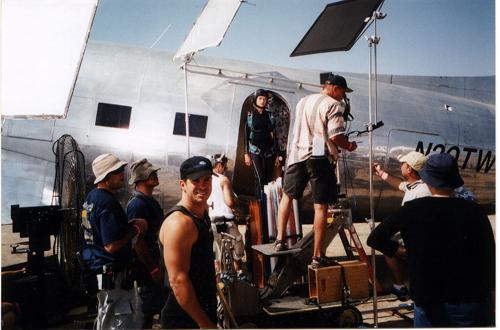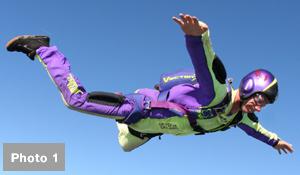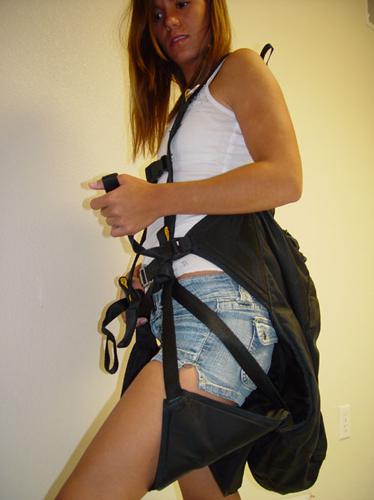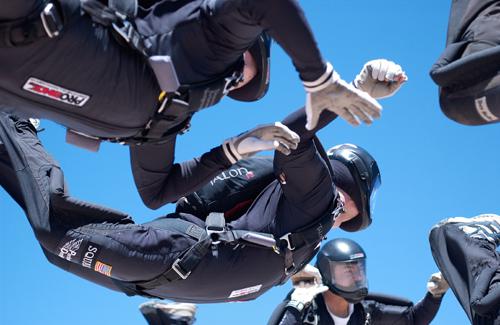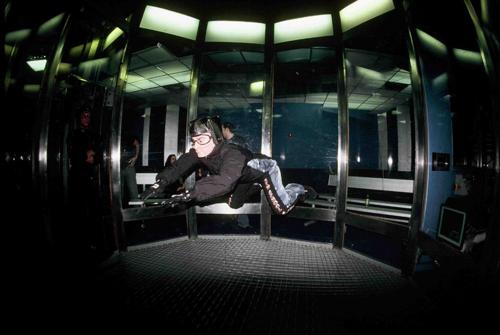Flying for Food
I majored in Business Management with a minor in Spanish and dreamed of working for an environmentally and culturally sensitive corporation like Coke. My life was on track, and thinking back, I imagine I'd have been quite successful. But I fell for a girl who lured me off course. I was wrapped around her finger and didn't know at the time that she would entirely derail my dreams and change the course of my life. She made me an addict, and today I'm selling the same stuff that became my addiction, and I'm perpetually unemployed between jobs.
She took me skydiving and now I fly camera for a living. It's a job I hadn't imagined, much less considered, but I like it!
In this article, I'll try to give you an idea of what goes into bidding, planning, and filming for a production, and some of the things that can happen along the way.
Bidding:
The first call from production is normally from a researcher who's never jumped. He or she explains the aerial sequence, or some version of it, and then asks what I'd charge to do the job. Most of the time I can tell that what I'm being told is probably far from what's actually needed. But the researcher doesn't need an earful from me about how little he or she knows about the sport. Her job is to get numbers as quickly as possible, and my job is to give her something that she can take to her boss, some rough numbers, ideas, and a few of my own questions to pass along. All things going well, her boss will call.
The basic bid for a skydiving project includes the location, aircraft, pilots, and skydivers, simple enough if the project requires a couple of jumpers in freefall over the local DZ. Most of the time, however, projects call for something more.
A skydiving sequence for a commercial or movie might call for two hidden rig jumpers grappling for a briefcase over downtown Los Angeles. Suddenly the project requires riggers, custom equipment, ground crew, ground transportation, landowner permission for some parking lot or rooftop, FAA paperwork and permits, police to keep the landing area clear, ground to air communication, sometimes green screen and studio facilities, and especially in the USA, endless and often impossible insurance issues.
When the producers call me with a story to tell. They need me to see the logistics behind the story and to bid accordingly. Sometimes I'll deliver a bid in an hour, sometimes it will take days to complete. The most valuable tool at this point is my rolodex.
SAG:
When I bid a SAG job, my terms include that I will be treated as a performer, just like the rest of the skydivers on the project.
When a producer balks, my argument is simple. I ask them when they last hired someone to perform a stunt off-camera. Camera people sometimes hang off cliffs or race along in cars following the action, but they don't actually perform the stunt, nor do they need the kind of training that goes into flying a camera. Picture this: A stunt driver flips a car over a river. The shot requires a chase vehicle with mounted cameras to follow behind and make the same jump. Imagine telling the second stunt driver he's not on-camera, so he doesn't get a SAG contract.
There are plenty more arguments like this, but they don't always work. A producer might stick to the off-camera argument and that's that, we reach an impasse.
As much as I want the work, I don't bend on this issue. Sometimes I'll get a call from a producer who just wants to know if I'd consider working without a SAG contract, and I'll know that they've reached the same impasse with one of my competitors. That's the only time I'll give in...just kidding!
Skydiving isn't a stunt:
After my rant about SAG, now I say skydiving isn't a stunt, but bear with me. Skydiving is a sport, much like surfing or skiing and skydivers are practicing it on all different levels and making thousands of jumps to better their skills. There are skydiving stunts, no doubt, just like surfing stunts, but skydiving itself isn't a stunt.
In productions, when there are surfing stunts, producers seek out surfers. When there's skydiving in a production, they call in stuntmen. Bummer for those who train! So I've been campaigning pretty hard to promote trained flyers.
I was advised early in my career to keep things "in the family" by some of the stuntmen I met along the way, but I saw things differently and ultimately "broke the code" as it were, to bring in trained jumpers who I knew from the competitive circuit. Some say I "shot myself in the foot", and its true to some degree. Why would a Hollywood stuntman recommend a camera flyer who works with outsiders? So I miss out on some work, but overall my reel is strong, mostly because the performers I film are terrific flyers.
Communication:
Storyboards, often called "boards", are a series of drawings, much like the frames of a comic book, that help us to visualize what the writer or director is hoping to see onscreen. After all, we're making a moving picture.
I know more about skydiving stunts than my clients, but they know more about storytelling than me. Often, a non-jumper will have some gem of an idea that I'd never considered. So I try to listen carefully before projecting too much of myself into the creative process, and my reel is better for it.
When I'm clear about what the director wants, I'll plan skydives that show each storyboard frame in a way that will transition smoothly from one shot to the next, and some skydives just to film "plates". Skydiving plates are aerial scenes without skydivers that are combined with action that's filmed in front of a "green screen".
The Green Screen:
If an actor is featured in the aerial sequence, we'll film him in front of a green screen where we try to match the light and wind as close as possible to the real action. When we do it right, I can claim the shot as my own. When we do it wrong (picture Elvis surfing), I'll blame production for screwing it up.
The green screen is both my friend and enemy. As a friend, it puts Lucie Lu into the action, and gives the impression that I'd filmed impossible things. As the enemy, it entirely replaces me. Insurers and lawyers, curse them all, sometimes drive the simplest of aerial stunts into the studio to be faked. And some directors feel that they can make skydiving look real, or better than real, in studio, with fans wires and green screens. Fortunately, the fake stuff just doesn't look all that good, so I'm not out of a job yet.
The Helmet:
I jump a modified 35mm motion picture camera with a video assist camera that lets the director see what I've filmed after each jump, and stills. My helmet weighs about 20 pounds. On some jobs, depending on the cameras I carry, the helmet can weigh up to 30 pounds. It's like jumping a bowling ball strapped to the top of my head. People ask how I handle the weight, what sort of workouts I do to build my neck and shoulders. The answer is, not all that much. I'm relatively fit and have done a few shrugs with dumbbells, and I swim to stay loose, but nothing extraordinary.
There are a lot of camera flyers who are far stronger than me, but suffer neck and back problems from jumping even light cameras. Maybe it's genetics. My father is 73 and has never seriously hurt his back. Considering some of the disgusting deployments I've endured over the years, I can only guess that I have him to thank for my longevity in this business.
Now I've been to the chiropractor a couple of times and its like "OK Joe, take a deeeep breath….. gooood, now let it out slowly and just relaaaax…. I'll just take a running start from the other side of the office and slam into your spine, and then twist your head around so that you can take a good look at your own ass." So I swim. It seems to keep me straight.
Before production:
At least a few days before a job, someone from the team will entirely take over coordinating. I'll have some input, but my attention is best focused on what the director wants and how to get it. I think over the boards, configure my helmet, choreograph and dirt dive with the team, set exposures, check my gear, and so-on. I don't multi-task well enough to worry about other details at the same time and I'm not concerned with being credited as a coordinator. Ultimately, I'm in this business to fly camera.
Production Day:
A lot of things have come together to get this far. Depending on the size and complexity of the project, anywhere from ten to fifty people or more will converge on set. It's refreshing to finally get out there to film, and by far, production is my favorite part of the job. It's also time to step up and deliver on a variety of levels. The pressure to perform reminds me of what if felt like to compete.
Competition experience is probably my biggest asset as a camera flyer. Training to compete taught me a lot about flying the camera aggressively, and competing taught me about teamwork and about staying loose under pressure.
The Team:
I rely heavily on the team around me. And my work is only as good as the team's work, Cliché, perhaps, but true. Flying with Rob Harris in skysurf competitions, I had my part on the team, and even part of the score. Mostly, though, my work supported Rob's performance, and I found myself cheering for him in flight. When Rob had a good round, I had a good round. When he won, I won.
Whenever possible, I fly with skydivers who've trained to compete on some level, and who perform well under pressure. On the ride to altitude, we're generally pretty quite, breathing and visualizing, eyes closed sometimes, rehearsing the dive. And it works. In the air, we're more fluid and relaxed, communicating but not over thinking, just doing what we'd planned.
A rigger who can keep a cool head under pressure is also a great asset on any production. On hidden rig projects, for example, almost everything is riding on the rigger's work. Hidden rigs look spectacular when they work, but the slightest flaw can cause the rig to be exposed or even to blow the wardrobe clear apart. So I find myself cheering for the riggers as much as for the performers in front of me. And when it all comes together, we're golden.
Harder than it looks:
"Easy" shots on the boards can be deceptively hard because storyboards invariably call for moves we haven't practiced or even tried. I've seen talented skydivers entirely caught off guard by some simple change in a move that causes them to flail around like a first jump student.
Try back layouts while "drinking" a soda, or "talking" on a cell phone, or maybe straddling another jumper without tumbling, or flying feet to earth while swinging a baseball bat. The list goes on and often includes hiding rigs or parts of rigs, or grappling while holding props, all the sort of things one rarely trains to do.
On most jobs, we don't have the chance to practice new things before filming, so we'll just take our best guess and go for it. The challenge for me is to predict fall rates and how much slide there will be. I can react as things move and chase the action around the sky, but my shot is a lot better when I'm able to fly proactively.
Things I don't like:
Assumptions: "Well, I assumed you'd have a black rig here for me, so I didn't bother to bring one", or, "I thought they were taking that frame off the boards. That's why I didn't bring the prop", or "Nobody called me about it, so I just assumed you wanted the cables to be built like this".
Screwing up: More than once, I jumped with the lens cap still on, jumped without a load of film, forgot my battery, forgot to turn the camera on, left my leg straps loose, forgot to latch on the helmet, set the focus for under a foot, exposed the same film twice, got onto the wrong plane, pulled too low, brain-locked in freefall, forgot to clip on my wings, walked to the plane without a rig, exited over the wrong place….. There but by the grace of god go I.
Grandstanding: The last thing I want to hear on set is some skydiver making a big announcement for everyone to hear, like "You might get some idiot to do it, but you'll never tape over that handle as long as I'm wearing the rig", or "If you want to see a helicopter crash, sure, hook that line to the skid". Of course we have to set and enforce our own parameters for safety, but it isn't us against them. With a bit of diplomacy, we can explain our limits without embarrassing our clients.
Jerk Producers: It's rare, but it happens.
Producer: "The director needs you to pass close to the cliff like on your reel."
Me: "If the winds calm, great, but right now they're blowing at 20+ miles per hour."
Producer: "Look, nothing personal, pal, but I've been in this business longer than you think. I hope you understand I didn't come all the way out here to pay for excuses."
Me: "Ok, let me talk with the guys" A few minutes later…."OK, we figured it out. We'll fly 100 meters from the wall. If the wind calms, we'll fly closer. And, we'll hang onto the exposed film until all payments for this job are received, nothing personal."
I suppose there are reasons to become jaded over the years in this business, but it isn't worth the negative energy. Most productions are great, and some are epic! And most producers are good people, and good at what they do.
Things I don't like (part 2):
Crash landing in an airplane
Hitting power lines in a helicopter
Landing on thin ice
Seeing another jumper get hurt
Landing in a yard with guard dogs
Being lost at night under canopy
Opening too far offshore
Hard openings
Extra heavy cameras
Whining (oops)
What I like:
Flying camera to tell a story
Visiting cool dropzones
Meeting great people
Traveling
Having family time between jobs
Planning unusual projects
Working through the physics of how objects fly
Getting the shot
Working with talented skydivers
Dropping big things like cars
Bragging about my cool job
Being called a "Bald Headed Action Figure" by my kids
Back in college, If someone said I'd fly camera for a living one day, I wouldn't have even known what they meant. And when I think back on the series of events that led me here, so much fell into place in ways I could never recreate. It makes me wonder where I'll be 20 years from now. I should thank the girl who lured me away from suits and polished shoes, maybe bring her something nice when I go home tonight.
~ Joe
Joe's Photo Galleries on Dropzone.com
Skydive.com - Joe's new project
Skydive.tv - Joe's web site

